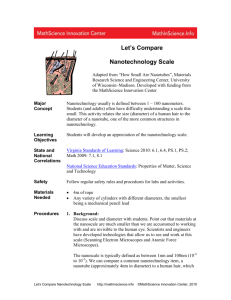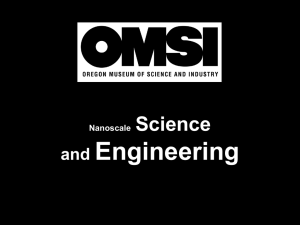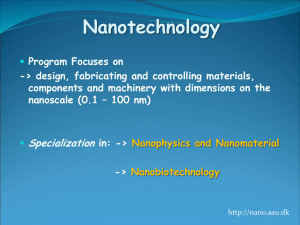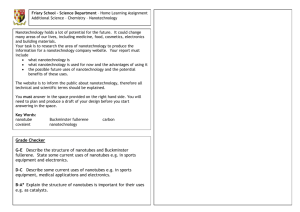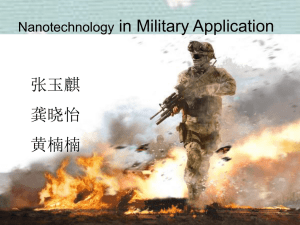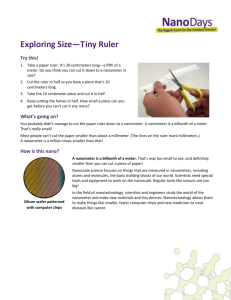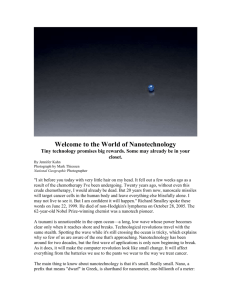Scale and Relative Size
advertisement
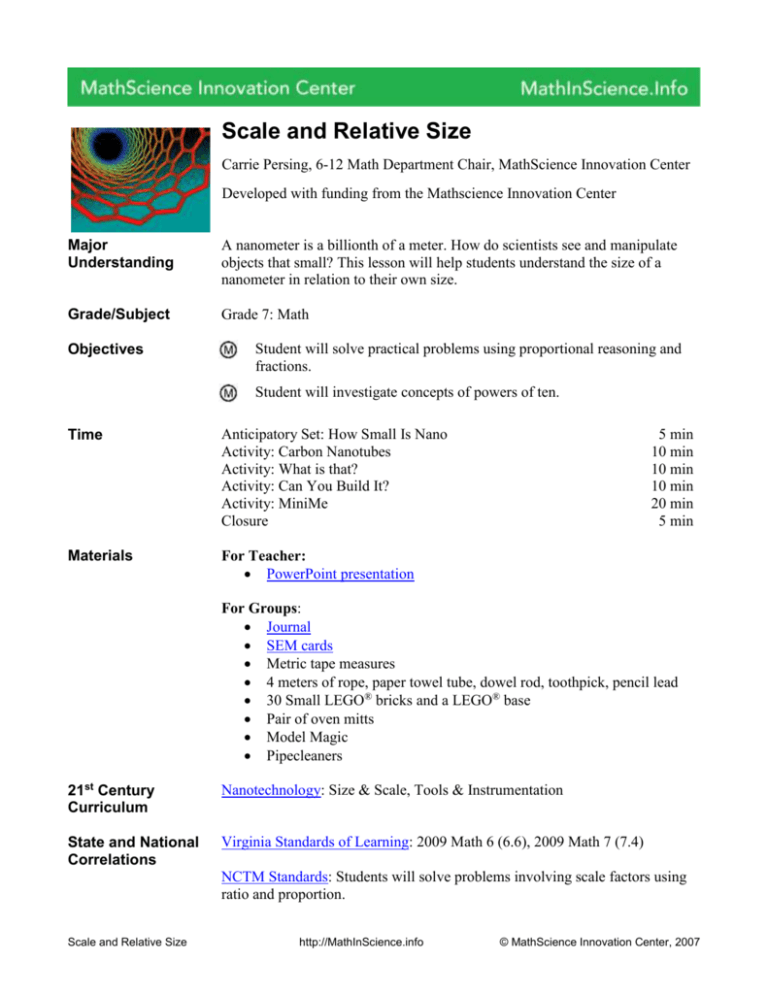
Scale and Relative Size Carrie Persing, 6-12 Math Department Chair, MathScience Innovation Center Developed with funding from the Mathscience Innovation Center Major Understanding A nanometer is a billionth of a meter. How do scientists see and manipulate objects that small? This lesson will help students understand the size of a nanometer in relation to their own size. Grade/Subject Grade 7: Math Objectives Student will solve practical problems using proportional reasoning and fractions. Student will investigate concepts of powers of ten. Time Anticipatory Set: How Small Is Nano Activity: Carbon Nanotubes Activity: What is that? Activity: Can You Build It? Activity: MiniMe Closure Materials For Teacher: PowerPoint presentation 5 min 10 min 10 min 10 min 20 min 5 min For Groups: Journal SEM cards Metric tape measures 4 meters of rope, paper towel tube, dowel rod, toothpick, pencil lead 30 Small LEGO® bricks and a LEGO® base Pair of oven mitts Model Magic Pipecleaners 21st Century Curriculum Nanotechnology: Size & Scale, Tools & Instrumentation State and National Correlations Virginia Standards of Learning: 2009 Math 6 (6.6), 2009 Math 7 (7.4) NCTM Standards: Students will solve problems involving scale factors using ratio and proportion. Scale and Relative Size http://MathInScience.info © MathScience Innovation Center, 2007 Instructional Strategies 1. Anticipatory Set (slides 1-3) 1.1. Ask students if they know how small a nanometer is. Discuss that in Greek “nano” means dwarf and in science, it means billionth. 1.2. Show students the video from nisenet.org (Intro to Nano). Discuss what they discovered about nanometers and nanotechnology watching the video. 1.3. Record their thoughts on the board or chart paper. 1.4. Explain that students are going to complete a few activities that will help them understand the size of a nanometer. 2. Activity: Carbon Nanotubes (slides 4-5) 2.1. Explain that length in nanometers is an important unit of measure for nanotechnology. 2.2. One exciting design in nanotechnology is carbon nanotubes. They are made up of bonded carbon atoms and have the highest strength-toweight ratio of any material but have a diameter of about 4 nm. Baseball bats are now being designed using carbon nanotubes in order to make them lighter and stronger. NASA is using carbon nanotubes to design lighter spacecraft. 2.3. Even though carbon nanotubes are 200 times stronger than steel, they are about 1,000 times thinner than the width of an average piece of human hair! That is pretty small. 2.4. First, have students compare the diameter of their wrist to the diameter of a piece of hair. 2.5. You will need to be outside or in an open area for this activity. Have all but four or five students form a circle with the 4 meters of rope. Hand the other cylindrical items to the other students. They will stand in the middle of the circle. 2.6. Let’s say that the 4 meters of rope represent a single piece of hair that has been magnified 100,000 times. Now look at each object and decide which would represent a carbon nanotube (4 nm). If the hair is 4 meters, the object would have to be 0.4 mm (pencil lead). 3. Activity: What Is That (slides 6-9) 3.1. Ask students how we could possibly see an object as small as a nanotube. Would a regular microscope work? Scale and Relative Size http://MathInScience.info © MathScience Innovation Center, 2007 3.2. Explain that scientists must use either an Atomic Force Microscope (AFM) or Scanning Electron Microscope (SEM) in order to see nanosized objects. 3.3. Show students slide 8. It is an image made by an SEM. Ask if they can tell what it is. (pollen) 3.4. Pass out a set of SEM cards to groups. Tell students that their job is to try and figure out what each picture represents. They can record their guesses in their journals. 3.5. After students have had time to discuss in their groups and make predictions, bring up slide 9. Ask students what they thought each image was. With each click, the image will disappear and reveal what the object was (a: bee leg; b: Horsefly Claw; c: Wasp Antennae; d: Grasshopper Head; e. Fly antennae; f: Moth fly head) 3.6. If one billion grains of salt fit in a tub what fraction of that is one grain? (one billionth) 3.7. If you would like to create cards of your own with objects like a staple, porcupine quill, toilet paper, etc., go to http://www.mos.org/sln/sem/quill.html 4. Activity: Can You Build It? (slides 10-11) 4.1. Pass out a bag of LEGO® bricks to each group. 4.2. Pass out oven mitts or mittens to half of the groups. 4.3. Show the picture on slide 10 and tell the students they have two minutes to build it. 4.4. Discuss what happened. Why couldn’t the groups with mittens on complete their building? 4.5. Scientists have to be able to manipulate objects at the nanoscale, but normal tools will not work. They have been able to create tools at that level like tweezers and lasers that will help. 5. Activity: Mini Me (slides 12-15) 5.1. In order for students to better understand a scale they cannot see, they will try to model themselves at a smaller scale. 5.2. Place students in groups of 4. Ask then to measure each other’s height, arm spam, and length of leg to the nearest centimeter. They will record Scale and Relative Size http://MathInScience.info © MathScience Innovation Center, 2007 their data in the journal. 5.3. Ask students to calculate their measurements to be 1/10 and 1/100 smaller. Discuss how small that would be. Explain that by shrinking by 1/10, students move from the meter scale to the centimeter scale. 5.4. Pass out model magic, pipe cleaners and scissors to each group. 5.5. Explain that they are going to create a “mini me” to model themselves at 1/10 and 1/100 of their size. The pipe cleaners need to be cut the appropriate lengths for their height, arm span and legs. The model magic will be shaped around the pipe cleaners to form a body and head. Closure After students have created their “mini me,” ask how many times they think they would have to shrink themselves to become the smallest size visible to the human eye (1,000). How about nano size? (10 million). Tell students to imaging their 1/10 “mini me” as an atom. A normal-sized person would be as tall as the distance around the Earth. End the lesson reviewing what they learned about nano scale and nano technology. Show the video “How Small is Nano?” from www.nisenet.org for a great illustration of scale and powers of ten. Extensions 1. DragonflyTV Materials: Internet access Students can be in groups of four for this activity. Dragnonfly TV on PBS has six different shows about nanotechnology. Show 1 introduces students to size and scale and nanotechnology. There are five different sections for Show 1. Have groups pick a section they would like to look at. They will go to http://pbskids.org/dragonflytv/nano/index.html and click on Show 1 and then the section they have chosen. Each group will report back to the class what was learned. Assessment 1. How can scientists see objects at the nano scale? Answer: atomic force or scanning electron microscope 2. How many times stronger is a carbon nanotube than steel? Answer: 200 3. If Sam is 56 inches tall, what height would he be if he were 10 times smaller? Answer: 5.6 inches References University of Wisconsin The nanotube and mitten challenge were adapted from this site. http://mrsec.wisc.edu/Edetc/ Duke University Scale and Relative Size http://MathInScience.info © MathScience Innovation Center, 2007 Dr. Frederik Nijhout’s Entomology class takes SEM pictures of insects each year and posts them on this site. The SEM sorting card pictures came from here. http://www.biology.duke.edu/dukeinsects/about.php NISE Network The videos used in this PowerPoint came from nisenet. It has videos, activities, posters and much more to teach nanotechnology. http://www.nisenet.org/ MathScience Innovation Center Information on educational programs available to students, teachers and school divisions, and procedures for registering for programs. http://msinnovation.info Scale and Relative Size http://MathInScience.info © MathScience Innovation Center, 2007
